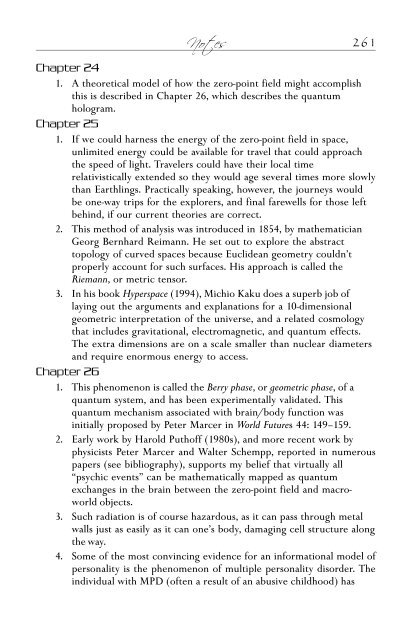edgar-mitchell
edgar-mitchell
edgar-mitchell
Create successful ePaper yourself
Turn your PDF publications into a flip-book with our unique Google optimized e-Paper software.
Invisible Realities 131<br />
would one day be subject to definitive forecast. But the existence of wave/<br />
particles that can have any number of probable values for their position<br />
and velocity in space-time between measurements causes the universe to<br />
be far more interesting, mysterious, and disturbing than one that is elegantly<br />
deterministic—and presumably less knowable. Yet a universe of<br />
probabilities still falls short of accounting for intentionality and choices<br />
that are made every minute.<br />
Einstein, at once unconvinced of the shortcomings of classical determinism<br />
and disturbed by the counterintuitive idea that one could say<br />
nothing about the underlying structure and movement of matter in the<br />
interval of space-time between measurements, devised various “thought<br />
experiments” to probe the validity of quantum theory.<br />
Exchanges between Einstein and Neils Bohr through the course of<br />
several decades proved the value of mentally dissecting experiments to<br />
discover truths and flaws. Because events at the atomic scale were too<br />
small to observe directly, thought and imagination were needed to create<br />
and think through both physical and thought experiments. As a result, the<br />
subtle line between external and internal reality, between physical experiments<br />
and thought experiments, began to blur even more. It has taken<br />
years for technology to catch up so that the subtleties of thought experiments<br />
could be physically tested. One such thought experiment has particular<br />
relevance to our story, as it illustrates the “supernatural” ways of<br />
nature.<br />
Imagine that protons, ejected from a source, go shooting off in different<br />
directions, tumbling and twisting as they go. The probable values of<br />
the attributes of each separate proton may be described by a separate<br />
Schrödinger wave equation. The values of the attributes of the two particles<br />
must remain correlated to each other, because they came from the<br />
same process and must obey the conservation laws, even though each at<br />
any moment could display a range of values for any particular attribute.<br />
Were one particle to be captured and measured in Princeton, New Jersey,<br />
for example, the other might at the same moment be in Bangkok. Values<br />
of the Princeton particle are suddenly known, and its wave equation collapses<br />
to known values. The Bangkok particle, could it also be captured<br />
and measured simultaneously, would have to display the appropriate values<br />
for its measured attributes because energy and momentum must be<br />
conserved, and the quantum attributes linked. These are fundamental laws<br />
of both quantum and Newtonian physics. What no one understood was<br />
how the Bangkok particle would instantly know that its partner has been<br />
captured, and its wave equation collapsed to correct specific values without<br />
violating the proven relativistic notion that signals cannot travel between<br />
Princeton and Bangkok faster than the speed of light.


